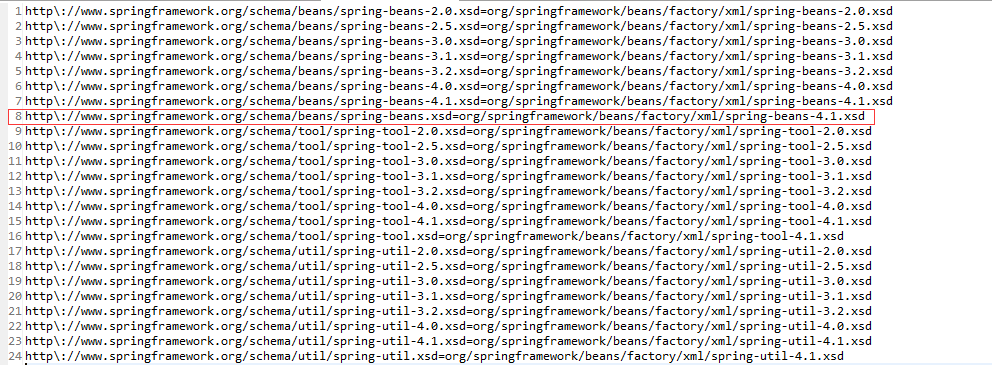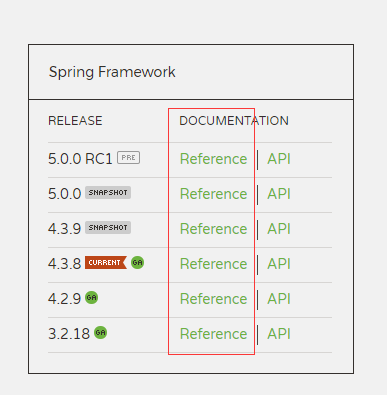Spring配置文件beans.xml头部配置解释
比如一个标准的beans.xml文件如下所示:
<?xml version="1.0" encoding="UTF-8"?> <beans xmlns="http://www.springframework.org/schema/beans" xmlns:xsi="http://www.w3.org/2001/XMLSchema-instance" xsi:schemaLocation="http://www.springframework.org/schema/beans http://www.springframework.org/schema/beans/spring-beans.xsd"> </beans>
解释:
1、【xmlns="http://www.springframework.org/schema/beans"】
声明xml文件默认的命名空间,表示未使用其他命名空间的所有标签的默认命名空间。
2、【xmlns:xsi="http://www.w3.org/2001/XMLSchema-instance"】
声明XML Schema实例,声明后就可以使用schemaLocation属性。
3、【xsi:schemaLocation="http://www.springframework.org/schema/beans http://www.springframework.org/schema/beans/spring-beans.xsd】
指定Schema的位置这个属性必须结合命名空间使用。这个属性有两个值,第一个值表示需要使用的命名空间。第二个值表示供命名空间使用的XML schema的位置。
上面配置的命名空间指定xsd规范文件,这样你在进行下面具体配置的时候就会根据这些xsd规范文件给出相应的提示,比如说每个标签是怎么写的,都有些什么属性是都可以智能提示的,在启动服务的时候也会根据xsd规范对配置进行校验。
配置技巧:对于属性值的写法是有规律的,中间使用空格隔开,后面的值是前面的补充,也就是说,前面的值是去除了xsd文件后得来的。
疑问:
对于一些配置文件上xsi:schemaLocation的属性是这样写的:
【xsi:schemaLocation="http://www.springframework.org/schema/beans http://www.springframework.org/schema/beans/spring-beans-3.0.xsd】
指定了具体版本,这个是什么意思?那么下次如何快速的知道是哪个版本?
解释:
在每个xsi:schemaLocation属性中,都是一个具有指定版本号的xsd文件,而对于没有加版本号的问题,是由于使用了默认值,实质上这个默认值是有一个具体的版本号的。当然,你也可以使用具体的版本号。
而对于这些xsd文件的路径查找的方法,可以定位到每一个jar包去找,比如上面使用了4.1.4版本beans的jar包,那么可以通过Eclipse打开spring-beans-4.1.4.RELEASE.jar文件,并打开META-INF/spring.schemas文件,如下所示:


可以看出,默认的地址上也是制定了具体的版本号的,那么根据后面的地址打开org/springframework/beans/factory/xml目录,如下所示:

可以看出最后会来这里定位xsd文件,从而实现标签的提示。
而这里只展示了要用的部分的url,一般这些都是根据自己的功能需要引入的,比如我要引入util的功能,那么url也可以通过这样的方法快速的找到这些地址。
注意:xsi:schemaLocation属性可以指定多个,指定多个的意思就是引入多个功能。
如下所示是一个引入了使用aop和tx功能的beans.xml文件:
<?xml version="1.0" encoding="UTF-8"?> <beans xmlns="http://www.springframework.org/schema/beans" xmlns:xsi="http://www.w3.org/2001/XMLSchema-instance" xmlns:aop="http://www.springframework.org/schema/aop" xmlns:tx="http://www.springframework.org/schema/tx" xsi:schemaLocation=" http://www.springframework.org/schema/beans http://www.springframework.org/schema/beans/spring-beans.xsd http://www.springframework.org/schema/tx http://www.springframework.org/schema/tx/spring-tx.xsd http://www.springframework.org/schema/aop http://www.springframework.org/schema/aop/spring-aop.xsd"> ... </beans>
解释:
1、【xmlns:aop="http://www.springframework.org/schema/aop"】
声明前缀为aop的命名空间,后面的URL用于标示命名空间的地址不会被解析器用于查找信息。其惟一的作用是赋予命名空间一个惟一的名称。当命名空间被定义在元素的开始标签中时,所有带有相同前缀的子元素都会与同一个命名空间相关联。
同时也是为beans.xml文件引入aop的功能,引入后就可以在包裹的范围内使用<aop>标签。
2、【xmlns:tx="http://www.springframework.org/schema/tx"】
原理同上。
3、xsi:schemaLocation属性同上解释,使用快速的方法来定位和编写这个url。
一些技巧:
关于在beans.xml要使用哪些功能,官网上已经提供了每个功能说明和标准的头文件信息,当我们在开发使用时要哪些功能,都可以上官网去定位。
http://docs.spring.io/spring/docs/current/spring-framework-reference/htmlsingle/#xsd-configuration
其实这个地址的入口在这里http://projects.spring.io/spring-framework/,打开之后,定位到右边边,想要哪个版本点进去即可。

关于书写的技巧,比如一些标签已经没有内嵌了,那么会有两种写法,这两种写法效果都是一直的,如:<context:annotation-config/>和<context:annotation-config></context:annotation-config>,为了美观来说,我们会选择前者。
总结:
XML Schema命名空间避免命名冲突,就像Java中的package一样,将不同作用的标签分门别类(比如Spring中的tx命名空间针对事务类的标签,context命名空间针对组件的标签)。
参考:
http://iswift.iteye.com/blog/1657537
http://www.oschina.net/question/107380_111872?sort=time
http://blog.csdn.net/f_639584391/article/details/50167321


